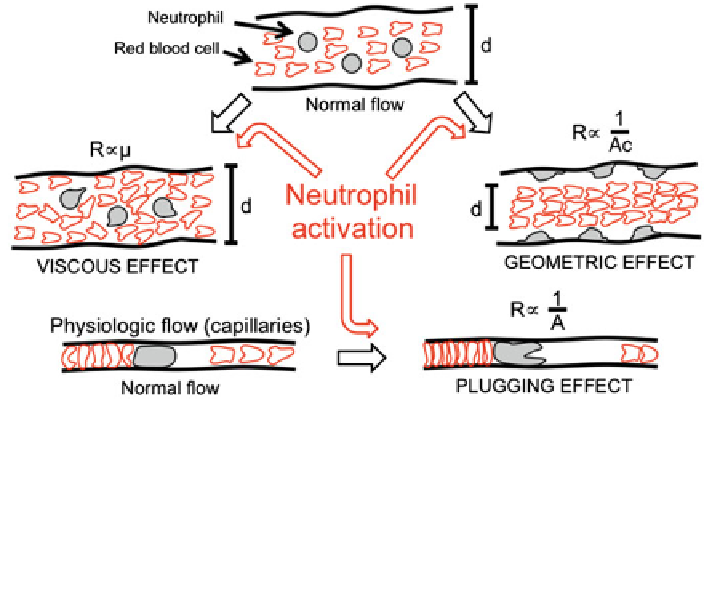Biomedical Engineering Reference
In-Depth Information
Fig. 3 Potential rheological effects of neutrophil activation on microvascular blood flow. Cell
activation (e.g., due to proinflammatory stimuli or impaired shear mechanotransduction) hinders
leukocyte passage through the small non-capillary vessels either by promoting pseudopod
projections (Viscous effect) or through enabling cell adhesion to the vascular wall (Geometric
effect). Pseudopod formation by neutrophils also reduces cell velocities in the capillaries
(Plugging effect). Ultimately, these may elevate peripheral resistance (R) by affecting the
apparent viscosity (l) of blood (Viscous effect), cross-sectional areas (Ac) of microvessels
(Geometric effect) or total cross-sectional microvascular area (A) to blood flow (Plugging effect),
and in doing so, influence tissue perfusion (adapted from [
93
])
activated neutrophils with F-actin enriched pseudopods will exhibit reduced
velocities in capillaries, owing to their enhanced stiffness that impedes their ability
to ''squeeze'' through the passage [
83
,
84
]. Consequently, neutrophils may impede
blood flow by reducing the cross-sectional area of the microcirculation. In doing
so, capillary plugging (Fig.
3
, Plugging effect) may influence microvascular blood
flow with an enhancing effect on hemodynamic resistance.
Another effect that pseudopods have on microvascular flow is alteration of the
neutrophil flow behavior in the non-capillary microcirculation. Conceivably,
pseudopod projection enhances neutrophil tumbling in the parabolic velocity field
of blood flow within the non-capillary microvessels (e.g., venules, arterioles),
leading to an increase in their collisions with the surrounding RBCs [
85
,
86
].
These collisions displace RBCs from their axial position and into the peripheral
cell-free plasma layer characteristic of microvascular flow. In line with the Fah-
reus-Lindqvist effect, these events may unfavorably impact the apparent viscosity
of blood [
85
,
86
], and in doing so raise microvascular flow resistance (Fig.
3
,
Viscous effect).
For example, Helmke et al. explored the influence of stochastic leukocyte colli-
sions with RBCs on blood flow resistance of intact microvascular networks in
ex vivo rat skeletal muscle preparations. For leukocyte suspensions (at physiological

Search WWH ::

Custom Search